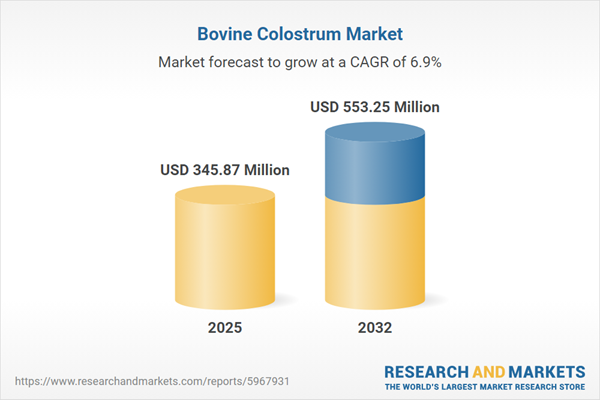Speak directly to the analyst to clarify any post sales queries you may have.
The bovine colostrum market is rapidly evolving, unlocking new opportunities in health and wellness sectors as both product innovation and strategic partnerships accelerate. Senior decision-makers are focusing on growing demand, advanced processing technologies, and expanding applications worldwide to secure enduring competitive advantage.
Market Snapshot: Bovine Colostrum Market Growth and Outlook
The bovine colostrum market grew from USD 323.36 million in 2024 to USD 345.87 million in 2025 and is projected to reach USD 553.25 million by 2032, advancing at a CAGR of 6.94%. Market expansion is driven by applications ranging from human dietary supplements to functional foods, animal nutrition, and specialty ingredient solutions. Increased interest in immune health, next-generation product formulations, and athletic recovery fuels investment and innovation momentum across regions and channels.
Scope & Segmentation
- Forms: Capsules, liquids, powders, tablets – Each format responds to distinct consumer needs for convenience, stability, and absorption, influencing manufacturing protocols and distribution decisions.
- Applications: Animal feed uses for immune modulation, dietary supplements focusing on immune support, functional foods and beverages for differentiation, infant formula targeting early-life nutrition, and sports nutrition emphasizing performance and recovery.
- Distribution Channels: Direct sales models enable tailored solutions and relationship-driven selling; e-commerce broadens global reach; pharmacies and drug stores highlight medical collaboration; specialty stores appeal to premium segments; supermarkets expand routine accessibility.
- Regional Coverage:
- Americas, including North America (United States, Canada, Mexico) and Latin America (Brazil, Argentina, Chile, Colombia, Peru).
- Europe, Middle East & Africa, with focus markets such as United Kingdom, Germany, France, Russia, Italy, Spain, Netherlands, Sweden, Poland, Switzerland, UAE, Saudi Arabia, Qatar, Turkey, Israel, South Africa, Nigeria, Egypt, Kenya.
- Asia-Pacific, with key countries being China, India, Japan, Australia, South Korea, Indonesia, Thailand, Malaysia, Singapore, Taiwan.
- Leading Companies Analyzed: Fonterra Co-operative Group Limited, Arla Foods amba, Dairy Farmers of America, Inc., Agropur Cooperative, Saputo Inc., Royal FrieslandCampina N.V., Glanbia plc, Kerry Group plc, DMK Deutsches Milchkontor GmbH, Groupe Lactalis.
Bovine Colostrum Market: Key Takeaways for Decision-Makers
- The market's resurgence is increasingly connected to its role in premium wellness solutions, supporting product differentiation and meeting demand for immune-boosting ingredients in both human and animal health.
- Industry adoption of advanced membrane filtration and microencapsulation is improving bioavailability and stability, enabling novel formulations and enhancing competitive positioning.
- Strategic partnerships among producers, distributors, and biotech innovators are driving the validation of therapeutic efficacy and accelerating regulatory acceptance for new applications.
- Regional strategies, including local sourcing and digital traceability initiatives, support quality assurance, transparency, and faster adaptation to evolving compliance standards.
- Cross-sector knowledge transfer between animal health and nutritional science is increasing operational efficiency and expanding marketable opportunities.
- Leading players are leveraging clinical trials, influencer collaborations, and targeted marketing to reinforce credibility and expand reach into growing segments.
Tariff Impact: Navigating Production and Supply Chain Adjustments
Recent United States tariff changes have influenced import dynamics and supply chain management, prompting local producers to expand capacity and optimize sourcing strategies. Some industry participants are pursuing vertical integration, forging partnerships with dairy cooperatives to secure raw materials and stabilize operations. Others are proactively diversifying ingredient portfolios to balance cost volatility and maintain product quality. These adaptations are reshaping competitive strategies, driving a recalibration of both supplier relationships and logistics frameworks within the domestic market.
Methodology & Data Sources
This report delivers insights grounded in a robust, multi-stage research framework. Comprehensive secondary research covered scientific literature, regulatory documents, and market periodicals, while primary research engaged senior executives, formulation specialists, and supply chain experts through structured interviews. Quantitative analysis triangulated data from trade associations, production figures, and tariff records. Qualitative perspectives were synthesized using thematic analysis and peer review to ensure integrity and actionable conclusions.
Why This Report Matters
- Clarifies actionable growth levers and strategic imperatives across forms, applications, distribution, and geographies.
- Supports informed decision-making for R&D investment, risk mitigation, and market expansion pathways.
- Enables senior leaders to benchmark competitors and anticipate disruption in a dynamic, compliance-driven landscape.
Conclusion
As the bovine colostrum market adapts to technological progress and global demand, strategic focus on innovation, supply resilience, and segmentation is essential. This report empowers executive action to drive lasting impact and leadership within the evolving sector.
Additional Product Information:
- Purchase of this report includes 1 year online access with quarterly updates.
- This report can be updated on request. Please contact our Customer Experience team using the Ask a Question widget on our website.
Table of Contents
3. Executive Summary
4. Market Overview
7. Cumulative Impact of Artificial Intelligence 2025
Companies Mentioned
The companies profiled in this Bovine Colostrum market report include:- Fonterra Co-operative Group Limited
- Arla Foods amba
- Dairy Farmers of America, Inc.
- Agropur Cooperative
- Saputo Inc.
- Royal FrieslandCampina N.V.
- Glanbia plc
- Kerry Group plc
- DMK Deutsches Milchkontor GmbH
- Groupe Lactalis
Table Information
| Report Attribute | Details |
|---|---|
| No. of Pages | 196 |
| Published | October 2025 |
| Forecast Period | 2025 - 2032 |
| Estimated Market Value ( USD | $ 345.87 Million |
| Forecasted Market Value ( USD | $ 553.25 Million |
| Compound Annual Growth Rate | 6.9% |
| Regions Covered | Global |
| No. of Companies Mentioned | 11 |








